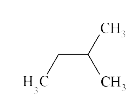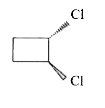Amongst the following compounds, the optically active alkane having lowest molecular mass is:




To determine the optically active alkane with the lowest molecular mass among the given compounds, we will follow these steps:
Step 1: Understand Optically Active Compounds
An optically active compound must have a chiral carbon atom, which is a carbon atom bonded to four different groups.
Hint: Look for chiral centers in the structures of the compounds.
Step 2: Analyze Each Compound
We will analyze each of the four compounds provided to identify if they contain a chiral carbon atom.
1. First Compound:
- Structure: CH3-CH2-CH3 (Propane)
- Analysis: All carbon atoms are bonded to either 2 or 3 hydrogen atoms. No chiral carbon is present.
- Conclusion: Not optically active.
2. Second Compound:
- Structure: CH3-C≡C-CH3 (Butyne)
- Analysis: The carbon involved in the triple bond does not have four different groups attached. No chiral carbon is present.
- Conclusion: Not optically active.
3. Third Compound:
- Structure: CH3-CH(CH3)-C2H5 (Cyclopropane derivative)
- Analysis: The central carbon is attached to four different groups: a methyl group (CH3), an ethyl group (C2H5), a hydrogen (H), and a part of the cyclopropane ring. This carbon is chiral.
- Conclusion: This compound is optically active.
4. Fourth Compound:
- Structure: CH3-C(CH3)2-CH3 (Tert-butyl)
- Analysis: The central carbon is attached to three methyl groups and one hydrogen. No chiral carbon is present.
- Conclusion: Not optically active.
Step 3: Determine Molecular Mass
Now that we have identified the optically active compound (the third compound), we need to calculate its molecular mass to ensure it is the lowest among the options.
- Molecular Mass of the Third Compound (CH3-CH(CH3)-C2H5):
- Carbon (C): 3 (from CH3) + 1 (from CH) + 2 (from C2H5) = 6 Carbons
- Hydrogen (H): 3 (from CH3) + 1 (from CH) + 5 (from C2H5) = 9 Hydrogens
- Molecular Mass = (6 × 12) + (9 × 1) = 72 + 9 = 81 g/mol
Conclusion
The optically active alkane with the lowest molecular mass among the given compounds is the third compound.
Final Answer: The third compound is the optically active alkane with the lowest molecular mass.
An optically active compound must have a chiral carbon atom, which is a carbon atom bonded to four different groups.
We will analyze each of the four compounds provided to identify if they contain a chiral carbon atom.
- Structure: CH3-CH2-CH3 (Propane)
- Analysis: All carbon atoms are bonded to either 2 or 3 hydrogen atoms. No chiral carbon is present.
- Conclusion: Not optically active.
- Structure: CH3-C≡C-CH3 (Butyne)
- Analysis: The carbon involved in the triple bond does not have four different groups attached. No chiral carbon is present.
- Conclusion: Not optically active.
- Structure: CH3-CH(CH3)-C2H5 (Cyclopropane derivative)
- Analysis: The central carbon is attached to four different groups: a methyl group (CH3), an ethyl group (C2H5), a hydrogen (H), and a part of the cyclopropane ring. This carbon is chiral.
- Conclusion: This compound is optically active.
- Structure: CH3-C(CH3)2-CH3 (Tert-butyl)
- Analysis: The central carbon is attached to three methyl groups and one hydrogen. No chiral carbon is present.
- Conclusion: Not optically active.
Now that we have identified the optically active compound (the third compound), we need to calculate its molecular mass to ensure it is the lowest among the options.
- Carbon (C): 3 (from CH3) + 1 (from CH) + 2 (from C2H5) = 6 Carbons
- Hydrogen (H): 3 (from CH3) + 1 (from CH) + 5 (from C2H5) = 9 Hydrogens
- Molecular Mass = (6 × 12) + (9 × 1) = 72 + 9 = 81 g/mol
The optically active alkane with the lowest molecular mass among the given compounds is the third compound.
Topper's Solved these Questions
- HYDROCARBONSBOOK - VMC MODULES ENGLISHCHAPTER - HYDROCARBONSEXERCISE - JEE Main Archive
46 Videos
- HALOALKANES AND HALOARENESBOOK - VMC MODULES ENGLISHCHAPTER - HALOALKANES AND HALOARENESEXERCISE - IN-CHAPTER EXERCISE - F
6 Videos
- ICONIC EQUILIBRIUMBOOK - VMC MODULES ENGLISHCHAPTER - ICONIC EQUILIBRIUMEXERCISE - IMPECCABLE
50 Videos
Similar Questions
Knowledge Check
Which of the following compounds is optically active?
A B
B C
C D
D
Which of the following compounds is optically active?
A B
B C
C D
D
Which of the following compounds is optically active ?
A1-BromobutaneB2-BromobutaneC1-Bromo-2-methylpropaneD2-Bromo-2-methylpropane
Which of the following is not optically active?
View SolutionWhich of the following is not optically active?
View SolutionWhich one of the following compounds show optical activity ?
View SolutionWhich one of the following compounds show optical activity
View SolutionWhich of the following compounds will be optically active?
View Solution

